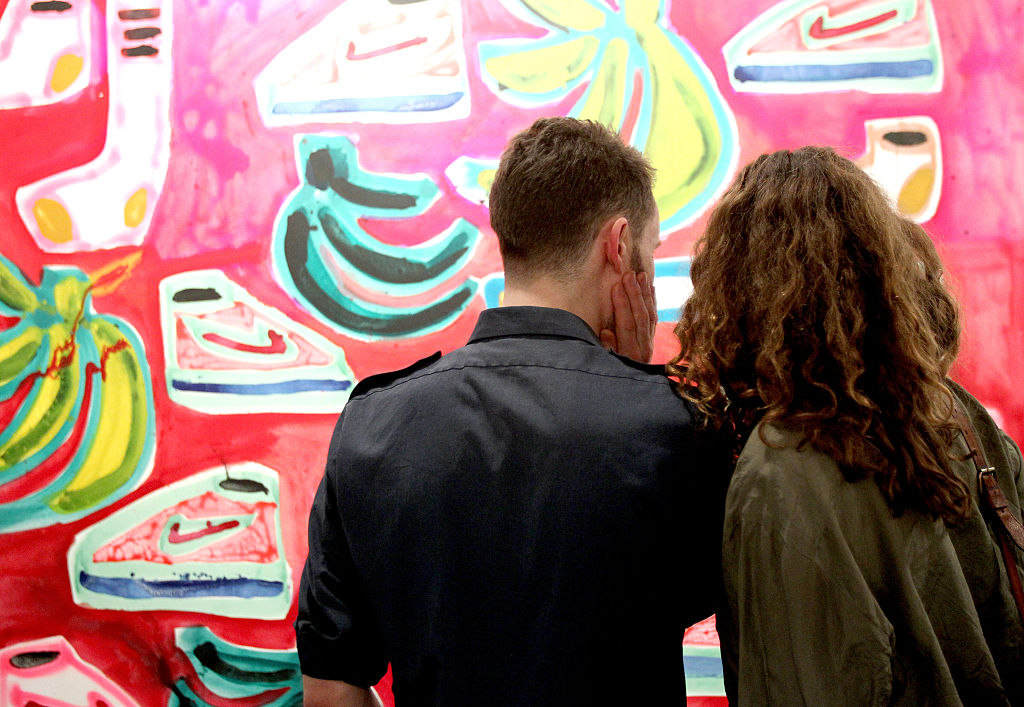
Notwithstanding a preponderance of vibrantly-colored abstract works that are custom-designed for West Coast walls, everything about the seventh edition of Art Los Angeles Contemporary feels like the right fit, from the volume of work shown, to an easily navigable open floor plan, to the alluring mix of US and international dealers with a range on material on view.
Just a few hours into the VIP preview January 28, the Santa Monica Airport’s Barker Hangar was filled with a vibrant and eclectic crowd.
SANTA MONICA, CA – JANUARY 28: A dog poses during the Art Los Angeles Contemporary 2016 Opening Night at Barker Hangar on January 28, 2016 in Santa Monica, California.
Photo by Angela Weiss/Getty Images for Art Los Angeles Contemporary.
The fair is undeniably heavy on cutting-edge names and artworks—and that is not a bad thing. But it also includes a healthy dose of historical material and artworks.
“It’s our hometown fair,” Kurt Mueller, director of David Kordansky Gallery, told artnet News. “It’s a unique platform to support solo projects and a new body of work. All of LA comes at once. It’s a nice moment.”
Matthew Brannon Chipped Teeth (2016)
Image: Courtesy of the artist and David Kordansky Gallery.
The Kordansky Gallery’s booth was given over to a solo presentation of new works by Matthew Brannon that was clearly creating buzz and was admittedly one of our top picks of the night. Brannon has used his distinctive “mid-century graphic design,” as Mueller described it, to delve into the era of the Vietnam War, specifically through the lens of the four presidents who held office during the lead-up to and exit from the protracted conflict.
Liam Everett Untitled (Montpelier) (2015)
Image: Courtesy of the artist and Altman Siegel, San Francisco.
Another standout was the booth of San Francisco’s Altman Siegel Gallery, which had a tightly curated display of works including Liam Everett’s multi-layered and heavily worked paintings, Nate Boyce’s prints (die sublimation on aluminum) showing mash-ups of imagined environments with inexplicable sculptural elements, and Trevor Paglen’s Color Study Pelican Bay State Prison (2015), which suggests a vivid and mesmerizing sunset but is actually a study of the light above the Crescent City prison in California.
Image: Courtesy Josh Lilley.
Since Altman Siegel opened in 2009, there has been a pronounced empahsis on California artists as well as building relationships with Los Angeles collectors, according to director Daelyn Farnham. This fair is “an opportunity to present the gallery program as a whole, but also the freedom to do something less curated,” she said.
London gallerist Josh Lilley, who handles a number of LA-based artists, also had an eye-catching booth which featured large-scale works by Nicholas Hatfull, a delightful series of ink and acrylic works by Christof Mascher that shows the influence of Hieronymus Bosch and Pieter Breughel, and sculptures by Kathleen Ryan, including an arresting, semi-abstract cluster of green glazed ceramic birds on steel perches.
Original exhibition poster from Warhol/Basquiat paintings at Tony Shafrazi Gallery in 1985.
Image: Courtesy of Alden Projects.
Todd Alden, director of the recently opened Alden Projects on New York’s Lower East Side, showed a dynamic mix of art historical works including photographs by Eleanor Antin, work by Larry Bell and ephemera related to John Baldessari, Andy Warhol, and Jean-Michel Basquiat.
SANTA MONICA, CA – JANUARY 28: A guest attends the Art Los Angeles Contemporary 2016 Opening Night at Barker Hangar on January 28, 2016 in Santa Monica, California.
Photo by Angela Weiss/Getty Images for Art Los Angeles Contemporary.
Night Gallery, which operates a well-regarded space in downtown LA, displayed a disorienting wall-mounted kitchen table sculptural installation by Samara Golden, whose major multi-level installation The Flat Side of the Knife, was a hit at MoMA PS1 in New York last year.
Asked about the appeal of the Art Los Angeles Contemporary fair for a local exhibitor, Mieke Marple, co-owner of Night Gallery, told artnet News that while not everyone in LA comes to the downtown gallery location, coming to Santa Monica is an easier proposition.
Marcel van Eeden, Untitled (2015)
Image: Courtesy of Clint Roenisch, Toronto.
Toronto’s Clint Roenisch Gallery, a first time exhibitor at ALAC, showed drawings by Dutch artist Marcel van Eeden, whose penchant for magnifying patterns or text on found material results in equally intriguing and inexplicable images.
The eponymous gallerist told artnet News he thinks the images have a sort of “film-noir” quality that looks good at this fair, and we agree.
SANTA MONICA, CA – JANUARY 28: Marching band performs during the Art Los Angeles Contemporary 2016 Opening Night at Barker Hangar on January 28, 2016 in Santa Monica, California.
Photo by Angela Weiss/Getty Images for Art Los Angeles Contemporary.
The fair’s newly incorporated “Freeways” section, featuring presentations by galleries younger than four years old and included “Smart Objects” an Echo Park gallery space run by artist Chadwick Gibson, who focuses his program on artists who are originally digitally based. The booth features compelling, one-of- a-kind works by Derek Paul Boyle, with intriguing titles, which Gibson describes as “symbolic minefields.”
Derek Paul Boyle Milk Hammer Rising(date)
Image: Courtesy of the artist and Smart Objects
Noting the continued growth of the fair scene and the larger LA scene, art attorney Christine Steiner told artnet News via email: “The larger art world is recognizing what Los Angeles knows: LA has an interconnected art market with world-class galleries, artists and museums, with a sophisticated collector base to support it.” She continued, “the consistency of this late January slot in the global art fair calendar bodes well for LA Contemporary.”